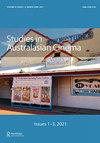Pushing the boundaries: creativity and constraint in Australian screen production
IF 0.7
0 FILM, RADIO, TELEVISION
引用次数: 0
Abstract
ABSTRACT Screen production is risky business. Significant sums of money are invested in a process that is subject to myriad precarious variables. Effective completion of a screen project is achieved through the instigation and monitoring of strict parameters which bound its creative process. However, filmmaker David Lynch states that ‘any restriction is a sadness and can kill creativity’ (Stratton 2015. David Lynch in Conversation. https://www.youtube.com/watch?v=jGd6lnYTTY8). The tension between flow and constraint in creative practice negotiates a delicate balance between efficiency and futility. At its most productive, limitations can provide a catalyst for innovation, whereas restrictions that are not sympathetic to the project’s creative intention can cause unproductive conflict and power struggles. Examination of this inherent tension deepens our understanding of the screen production process and offers broader insight into the nature of practice in the creative arts. Anecdotal evidence is drawn from interviews with screen practitioners and the author’s own experience working in various Australian film and television productions between 1994 and 2018. Findings are then examined alongside theories of creative work.突破界限:澳大利亚银幕制作中的创意与约束
摘要屏幕制作是一项有风险的业务。大量资金被投资于一个受到无数不稳定变量影响的过程中。一个屏幕项目的有效完成是通过严格的参数激励和监控来实现的,这些参数约束了它的创作过程。然而,电影制作人大卫·林奇表示,“任何限制都是一种悲伤,都可能扼杀创造力”(斯特拉顿,2015年)。大卫·林奇在《对话》中。https://www.youtube.com/watch?v=jGd6lnYTTY8)。创造性实践中的流动与约束之间的张力在效率与徒劳之间达成了微妙的平衡。在最有效的情况下,限制可以为创新提供催化剂,而不符合项目创造性意图的限制可能会导致非生产性的冲突和权力斗争。对这种内在张力的研究加深了我们对屏幕制作过程的理解,并为创造性艺术实践的本质提供了更广泛的见解。轶事证据来自对电影从业者的采访,以及作者本人在1994年至2018年间在澳大利亚各种电影和电视制作中的工作经历。研究结果与创造性工作的理论一起被检验。
本文章由计算机程序翻译,如有差异,请以英文原文为准。
求助全文
约1分钟内获得全文
求助全文

 求助内容:
求助内容: 应助结果提醒方式:
应助结果提醒方式:


